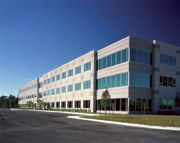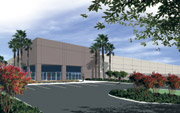Orlando —
Slow but Steady Weathers the Downturn
Greg Morrison, Tom McFadden and Bo Bradford
The commercial real estate engine in Florida isn’t running
on all cylinders — but it’s still running. It is arguably
even beginning to pick up steam, although still uncertain macroeconomic
conditions and a shaky local employment market continue to take
a toll on many of the state’s metropolitan areas. The fact
that the state is not largely dependent upon a strong manufacturing
base, coupled with the fact that many metropolitan areas have
fairly well diversified local economies, has prevented unemployment
from escalating beyond any controllable measure.
Orlando, Florida, has done a fairly good job of weathering the
economic storm despite several recent announcements of corporate
layoffs and continued downsizing, which are the inevitable result
of last year’s national economic contraction. Commercial
real estate activity is beginning to pick up once again, with
several recent investment transactions indicative of a perception
by investors that Orlando remains a strong market.
The Office Market
Nationwide office space fundamentals continue to struggle
against abnormally weak demand for office space, coupled with
significant sublease availabilities. Anticipated demand for
office space has not increased significantly and likely will
not until 2004, as labor market fundamentals continue to experience
losses. U.S. employers cut 108,000 jobs from their payrolls
in March, extending the longest streak of labor market pain
since 1944.
 |
|
University Corporate Center
II, developed by Opus South Corporation, is located
in Orlando’s Quadrangle Corporate Park. The
recently delivered building, which is leased by
Advantis, is indicative of current office development
trends.
|
|
The Lake Mary submarket (north Orlando) remains fairly replete
with newly delivered and still vacant space available; however,
it did experience positive net absorption during the first
quarter. The University submarket (east Orlando) just witnessed
the delivery of University Corporate Park II, a 103,995-square-foot
building, and will soon have to absorb the delivery of Crescent
Resources’ Three Resource Square, a 153,269-square-foot
building, which is still largely available. All in all, office
development has slowed and development trends have changed
somewhat. Mid-rise office buildings with high-end lobbies
and extensive common areas are slowly being replaced by low-rise
office buildings with efficient layouts, lower core factors
and higher parking ratios. Rental rates market-wide have continued
to decline, although their rate of decline continues to taper
off.
The majority of recent U.S. employment market losses occurred
within the services industry, which comprises much of south
Orlando’s local economic base. The good news is that so
far Orlando has yet to experience massive service employment
layoffs and tourism seems to be doing a fairly good job of weathering
the economic storm. Renewed leasing activity and improving net
absorption figures offer promise that 2003 will be better than
2002.
Orlando’s office market totals 28.01 million square feet
and has a current vacancy rate of 18.6 percent, a 0.7 percent
increase since year-end 2002. Many areas did experience healthy
leasing activity and the vacancy rate increase was partially
due to the delivery of a speculative office building in the
University submarket. Downtown Orlando has performed well so
far this year with a 1.4 percent decline in vacancy and positive
net absorption of 36,286 square feet. Several other areas also
performed well during the first quarter, although Maitland Center
and Lake Mary continue to struggle. Vacancies in both of these
areas should begin to improve once tenant contractions in the
telecom, software and tech markets begin to cease.
Several leases were transacted during the first quarter, although
none were significant. Continued pressure on the national economy
is encouraging many tenants to pursue renewing their existing
space at very favorable terms rather than moving their operations.
Increased tenant improvement dollars, rental abatement and other
concessions are not uncommon right now, but the willingness
of landlords to aggressively market available space has helped
to prevent an even greater rise in the current vacancy rate.
Net absorption, the greatest barometer of a market’s health,
is nearing equilibrium, although it likely may not be back in
positive territory until the third quarter of this year.
The Industrial Market
While the national economy continues to struggle with rising
unemployment, slowing economic growth, a widening trade deficit
and disappointing retail sales, it now appears as though the
engine of the local industrial market may well be starting to
rev up once again. The overall industrial vacancy rate in Orlando
has decreased 1.1 percent since year-end to a current rate of
9.2 percent, and the market experienced strong net absorption
during the first quarter. Long considered the bread and butter
of any commercial market, the industrial sector tends to rebound
at a faster rate than other sectors, and this quarter was no
exception. This does not mean that the ride is over, of course,
but that the market is now approaching a return to normal.
Fundamental demand for manufactured goods remains weak and vacancies
nationwide continue to slowly escalate as the United States
faces greater global competition. The Orlando market serves
as a regional distribution center for many companies, and its
health is therefore tied to the national economy. Fortunately,
the relative lack of a strong local manufacturing base has prevented
the local unemployment rate from edging even higher as that
industry has been hard hit by the U.S. economic slowdown. Leasing
activity did pick up during the first quarter. Several significant
leases were signed, and there are several tenants still at the
negotiating table.
At the end of 2002, seven out of 10 industrial submarkets had
recorded negative net absorption for the year. That number is
now down to one, and negative absorption in that submarket is
largely the result of a vacant, newly delivered building. The
south Orlando industrial market has rebounded well, although
uncertainty regarding the health of companies such as Recoton
and Siemens may further aggravate the vacancy rate should those
companies continue to downsize. The development pipeline remains
fairly small and the former glut of sublease space has diminished
— two factors that will assist the market’s recovery.
Current Industrial Development Trends
The most notable industrial development trend that has taken
place during the past year is the relative lack of development
activity in the Orlando market. National economic turmoil
that has trickled down to affect the local market has given
developers pause, and an uncertain stock market has created
a sense of hesitancy among investors and tenants alike. Fortunately,
those concerns are beginning to ease and construction cranes
are beginning to reappear.
 |
|
Opus South Corporation is developing
a 203,125-square-foot distribution facility at
Crownpointe Commerce Park in Orlando.
|
|
Speculative industrial product being developed in Orlando
today tends to be shallow depth, rear-load or cross-dock,
with clear heights at or above 30 feet. New projects are also
being developed to allow space for trailer drops, which provide
on-site trailer parking. Active developers include Opus South
Corporation, McDonald Development, Liberty Property Trust
and EastGroup Properties. The most significant new development
is a 203,125-square-foot cross-dock distribution facility
by Opus. The facility is located in Crownpointe Commerce Park
in the southwest submarket of Orlando and is slated for delivery
during the fourth quarter. Also under construction is Sunport
IV, a 150-foot deep, 63,325-square-foot warehouse/distribution
building being developed by EastGroup. Other key industrial
developers in the Orlando market include ProLogis and Duke
Realty Corporation, although they do not currently have any
significant speculative developments underway. While the southwest
area is currently the hotspot for industrial development in
Orlando, a close eye should be kept on both Polk and Lake
counties — two peripheral areas that offer great opportunities
for the development of large distribution facilities and both
of which have experienced steady growth in recent years.
In Conclusion
While the recent military campaign in the Middle East created
concern on Wall Street and affected consumer confidence, the
campaign’s successful conclusion is expected to greatly
assist the national economy and therefore the local industrial
market by default. Future development activity in Poinciana,
International Corporate Park and Crownpointe Commerce Park,
if delivered at a disciplined pace, could also serve as a catalyst
for companies that consider relocating to Central Florida. In
any event, it seems as though the tide has begun to turn. Orlando’s
industrial market metrics are improving, despite a decline in
national labor market fundamentals, and the area should experience
continued excellent long-term economic prospects.
Greg Morrison is executive director, and Tom McFadden
and Bo Bradford are senior directors of Advantis Real Estate
Services Company in Orlando.
©2003 France Publications, Inc. Duplication
or reproduction of this article not permitted without authorization
from France Publications, Inc. For information on reprints
of this article contact Barbara
Sherer at (630) 554-6054.
|
